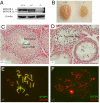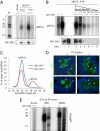Mouse MOV10L1 associates with Piwi proteins and is an essential component of the Piwi-interacting RNA (piRNA) pathway
- PMID: 20534472
- PMCID: PMC2900664
- DOI: 10.1073/pnas.1003953107
Mouse MOV10L1 associates with Piwi proteins and is an essential component of the Piwi-interacting RNA (piRNA) pathway
Abstract
Piwi-interacting RNAs (piRNAs) are essential for silencing of transposable elements in the germline, but their biogenesis is poorly understood. Here we demonstrate that MOV10L1, a germ cell-specific putative RNA helicase, is associated with Piwi proteins. Genetic disruption of the MOV10L1 RNA helicase domain in mice renders both MILI and MIWI2 devoid of piRNAs. Absence of a functional piRNA pathway in Mov10l1 mutant testes causes loss of DNA methylation and subsequent derepression of retrotransposons in germ cells. The Mov10l1 mutant males are sterile owing to complete meiotic arrest. This mouse mutant expresses Piwi proteins but lacks piRNAs, suggesting that MOV10L1 is required for piRNA biogenesis and/or loading to Piwi proteins.
Conflict of interest statement
The authors declare no conflict of interest.
Figures




References
-
- Kim VN, Han J, Siomi MC. Biogenesis of small RNAs in animals. Nat Rev Mol Cell Biol. 2009;10:126–139. - PubMed
Publication types
MeSH terms
Substances
Associated data
- Actions
Grants and funding
LinkOut - more resources
Full Text Sources
Molecular Biology Databases

